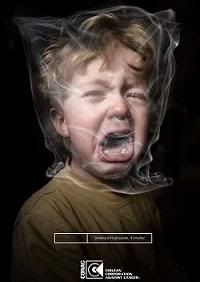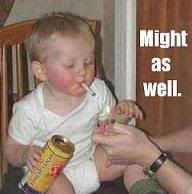
The scientific evidence on the health risks of exposure to secondhand and thirdhand smoke is alarming to me as a mother. I see friends and family smoking around young children quite often and it's made me wonder each time if maybe they aren't sure of the facts, or if they just don't care. Today's blog will address the facts of second and thirdhand smoke and how it affects children.
Most of us know that secondhand smoke (also referred to as involuntary smoking and passive smoking) is a known cause of lung cancer, heart disease, low birth-weight births and chronic lung ailments, as those are generally most commonly listed on your cigarette pack, even though the warning is aimed at the smoker themselves. But there are many other problems secondhand smoke can cause to the ones we love most, even if you aren't blowing smoke directly into their faces. According to the Centers for Disease Control and Prevention (CDC), nearly 50,000 Americans die each year from lung cancer and heart disease attributable just to secondhand smoke exposure alone.
Being exposed to someone that smokes, even if they just smoke outside the home, increases a child's chance of having ear infections, allergies, asthma, wheezing, pneumonia and frequent upper respiratory tract infections, among other things. Studies have found that children who are constantly coming down with sicknesses throughout each year, live in a home where one or both parents smoke, as the second hand smoke considerably weakens the child's immune system.
Did you know that there is such thing as thirdhand smoke? It's the particles in secondhand smoke that settle onto carpets, furniture, clothes, drapes, walls and other surfaces. It's most dangerously found in household dust which becomes airborne and is inhaled by everyone who enters the home (or any other area that a smoker enters). Children are also at a higher risk for ingesting thirdhand smoke by placing things in their mouth (including their hands after they have touched the hand of a smoker, etc.) that have been contaminated.
Children face a higher risk than adults of the negative effects of secondhand and thirdhand smoke. Not only is a child's body still developing physically, but their breathing rate is faster than that of adults. Adults breathe in and out approximately 14 to 18 times a minute, where newborns can breathe as many as 60 times a minute. Up until a child is about 5 years old, the
respiratory rate is quite fast; usually between 20 and 60 breaths per minute. When the air is tainted with cigarette smoke, young, developing lungs receive a higher concentration of inhaled toxins than do older lungs.
Among children under 18 months of age in the United States, secondhand smoke is associated with as many as 300,000 cases of
bronchitis or pneumonia each year. Children in smoking households experience more middle ear infections and are more likely to need an operation to insert ear tubes for drainage. Inhaled cigarette smoke irritates the Eustachian tube, and the subsequent swelling leads to infections, which are the most common cause of hearing loss in children.
Ingredients in second and thirdhand smoke include:
Arsenic (rat poison)
Carbon Monoxide (car exhaust)
Cadmium (chemical in batteries)
Mercury (liquid metal)
Vinyl chloride (found in PVC pipe)
Formaldehyde (embalming fluid)
Hydrogen cyanide (chemical weapon)
Acetone (nail polish remover)
Nicotine (addictive drug and pesticide)
Toluene (paint thinner)
Methanol (rocket fuel)
Butane (lighter fluid)
Ammonia (cleaner)
Lead (metal used in buildings)
Nickel (metal in batteries)
Polonium (radioactive element)
For a bigger list of ingredients in cigarette smoke, click HERE.
This was an ad against smoking around children that was launched in Russia:
Did you know?
-Children who spend one hour in an extremely smoky room inhale enough toxic chemicals to equal smoking 10 cigarettes.
-Infants who are exposed to a caregiver that smokes are up to 4 times more likely to die of Sudden Infant Death Syndrome
(SIDS).
-Exposure to secondhand smoke has been estimated to result in over one million illnesses in children.
-It has been estimated that between 50 and 75 percent of children in the United States have detectable levels of cotanine (A substance that is created through the metabolism of nicotine. Measuring the amount of cotinine in a person's bloodstream, urine or saliva is generally accepted as a reliable way to assess recent tobacco use or secondhand smoke exposure.) in their bloodstream.
-It can take three or more hours for the smoke of one cigarette to clear a room or confined space.
-In 2007, the American Academy of Pediatrics adopted a resolution encouraging all it's member state and local societies and chapters to "support and advocate for changes in existing state and local laws and policies that protect children from secondhand smoke exposure by prohibiting smoking in any vehicle while a legal minor (under 18 years of age) is in the vehicle."
-Studies have linked exposure to secondhand smoke to increased learning disabilities and Attention Deficit Hyperactivity Disorder (ADHD) in children.
Let's continue with some facts from the U.S. Surgeon General. Some of their statements on Children and Secondhand Smoke:
• "Secondhand smoke contains more than 250 chemicals known to be toxic or carcinogenic (cancer causing), including formaldehyde, benzene, vinyl chloride, arsenic, ammonia, and hydrogen cyanide. Children who are exposed to secondhand smoke are inhaling many of the same cancer-causing substances and poisons as smokers."
• "Because their bodies are developing, infants and young children are especially vulnerable to the poisons in secondhand smoke."
• "Babies who are exposed to secondhand smoke after birth are more likely to die from sudden infant death syndrome (SIDS) than babies who are not exposed to cigarette smoke."
• "Secondhand smoke exposure causes acute lower respiratory infections such as bronchitis and pneumonia in infants and young children."
• "Secondhand smoke exposure causes children who already have asthma to experience more frequent and severe attacks."
• "Secondhand smoke exposure causes respiratory symptoms, including cough, phlegm, wheeze, and breathlessness, among school-aged children."
• "Children exposed to secondhand smoke are at increased risk for ear infections and are more likely to need an operation to insert ear tubes for drainage."
• "The Surgeon General has concluded that the only way to fully protect yourself and your loved ones from the dangers of secondhand smoke is through 100% smoke-free environments."
The American Academy of Pediatrics has made the following conclusion regarding exposure of children to secondhand smoke:
• "Results of epidemiologic studies provide evidence that exposure of children to environmental tobacco smoke is associated with increased rates of lower respiratory illness and increased rates of middle ear effusion, asthma, and sudden infant death syndrome."
There is an endless amount of information on second and thirdhand smoke. I encourage anyone with a child and anyone who smokes to research it for yourself, and educate yourself and your loved ones on the serious and life threatening risks of second and thirdhand smoke. Remember, using fans, exhaust systems, air cleaners or opening windows does not eliminate all the toxins from tobacco smoke and cannot keep you or your family safe. The Surgeon General concluded that the only way to fully protect yourself and your loved ones from the dangers of secondhand smoke is through 100% smoke-free environments.
Babies and children don't have the ability to simply up and leave, get in their vehicles and drive away from smoke ridden areas... They are depending on us as parents to provide them with clean air to breathe! Also remember that kids of a parent/parents (or who are around other relatives or friends that they look up to) who smokes are more likely to start smoking themselves when they get older. I know that those of you out there who smoke wouldn't wish the dependency or health problems on your children, so do yourselves and those who love you with all that they have a favor, and get help quitting today!

Get help today...
SMOKE FREEQUIT.NETHELP GUIDE TO QUITTING
Information gathered from:
CAMPAIGN FOR TOBACCO-FREE KIDS
DPH: SECONDHAND SMOKE
SCIENCE DAILY
I added a link below to a product known as the E-cigarette. It's like a cigarette, but not as harmful and is known as a very effective way to wean yourself off of cigarettes! Good luck!


No comments:
Post a Comment
Please leave a comment or suggestion to help Mother Bear provide a greater experience here for you!